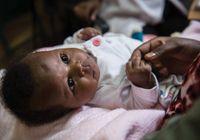
Neonatal mortality remains a key issue of public health concern in Kenya and currently stands at 20.5 per 1,000 live births[1]. In 2019, 39% of neonatal deaths were due to pre-term birth complications[2] and 26% due to intra-partum related events. Kenya continues to be among the top refugee hosting countries in Africa with over 500,000 refugees[3] and asylum seekers currently living in the country. Almost half (44%) of the refugees in Kenya reside in Dadaab in Eastern Kenya and 40% in Kakuma. In both camps and around the country, the population experiences cyclic humanitarian situations caused by conflict, harsh climatic conditions, population movements and disease outbreaks; and continue to record poor outcomes for newborns.
Health care services in Dadaab camps[4] are overseen by UNHCR and provided free-of-charge through a range of non-governmental organizations (NGO) partners that operate 16 health posts, four hospitals, and one stand-alone maternity centre, in addition to community outreach services. Providing health and other services in the camps is constrained for a number of reasons. Security issues, including kidnappings of humanitarian aid staff, improvised explosive devices, and attacks on refugee leaders and Kenyan police, have heightened security restrictions and made aid provision challenging.
In April 2019, UNICEF Kenya collaborated with the National and County Ministries of Health from Garissa and Wajir, to conduct an orientation workshop with key stakeholders such as UNHCR, Médecins Sans Frontières, International Rescue Committee, and Red Cross Kenya on implementing the recommendations of the Newborn Field Guide.
The workshop was attended by 30 representatives from local NGOs working as implementing partners, neonatologists and obstetricians representing county health offices, and professionals from WASHabbreviation, M&Eabbreviation, Gender and Nutrition sectors.
in addition to becoming sensitised to the needs of newborns in humanitarian settings, participants noted the need to include maternal and newborn health in national and sub-national emergency preparedness and response plans and the need to strengthen linkages across the various levels of care and the humanitarian-development sectors. Following the workshop, UNICEF has been working in Garissa to strengthen newborn health services provision at the community level, in line with the Newborn Field Guide recommendations, and is also currently setting up a learning hub for the community.
Additionally, the Newborn Field Guide, complemented by the KMC guidelines, were used by UNICEF Kenya to sensitise representatives from the Kenya Ministry of Health in the counties of Turkana (hosting the Kakuma refugee camp), West Pokot, Baringo and Samburu in August 2019. Participants in this sensitisation workshop included Chief Officers for Health, senior programme officers and other senior MOH representatives. The meeting was hosted by Baringo County in Kabarnet and it included a field visit to the newborn unit at Kabarnet County Referral Hospital.
As part of the session, participants from each of the counties were tasked to do a situational analysis in order to develop a comprehensive understanding of newborn health related needs, services and gaps in their counties. Counties acknowledged that in many of their facilities, care for small babies was still dependent on the use of incubators which were in short supply. The situational analyses also showed that all the newborn units in the 4 counties faced the challenge of inadequate staff to care for small babies and of the staff that was available, many lacked specialized skills to provide quality newborn care.
At the end of the workshop, participants committed to undertaking a few immediate steps such as rolling out KMCabbreviation to the sub-county hospitals and primary health care facilities, including neonatal data in quarterly review meeting and undertaking training of health care providers. There was also consensus for the need for long term planning and strengthening of multi-stakeholder coordination across all levels of care. The UNICEF field teams have been following up with counties on their progress.
7.2.1 Recommendations
There was consensus amongst participants on the following recommendations. These were consistent across Uganda, Kenya, and Ethiopia.
- Strengthening community engagement to identify and address community bottlenecks
- Strengthen linkages between refugee health facilities and host population facilities
- Better use of data from the surveillance team ensures preparedness and effective response in time
- Conducting training of managers, health professionals, community gate leaders and other stakeholders on newborn and patient friendly services
- Improving logistical support and redistribution of commodities
- Improving scientific evidence and innovation on models of care in fragile and humanitarian settings
- Mainstream existing guidelines with the newborn health in humanitarian situations

